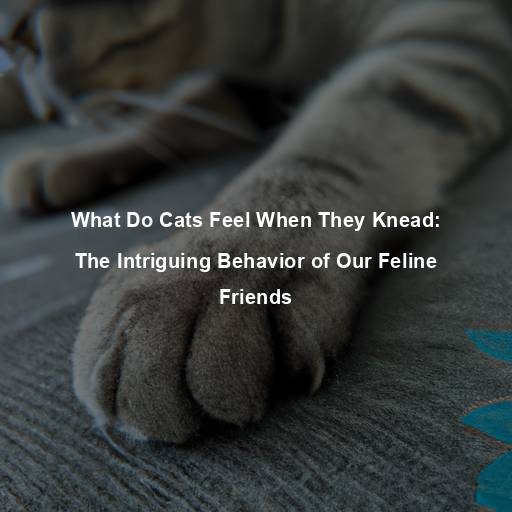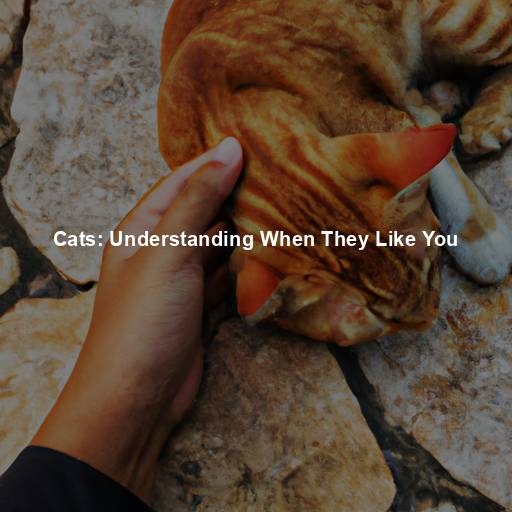What Do Cats Feel When They Knead: The Intriguing Behavior of Our Feline Friends
Last Updated on November 13, 2023 by Evan
Contents [hide]
- 1 Understanding the Fascinating Behavior of Kneading
- 1.1 The Origins of Kneading: A Behavior Rooted in Instinct
- 1.2 Comfort and Contentment: A Sign of Feline Serenity
- 1.3 Marking Territory: A Paws-on Approach
- 1.4 Nostalgia and Reminiscing: Fond Memories of Kittenhood
- 1.5 Bonding and Affection: A Show of Feline Love
- 1.6 Relieving Stress and Anxiety: A Therapeutic Motion
- 1.7 Preparing a Cozy Nest: The Maternal Instinct
- 1.8 Seeking Attention: A Paw-sitive Interaction
- 2 Decoding the Emotions Behind Kneading
- 3 Tips for Encouraging and Enjoying Kneading
- 3.1 Creating a Safe and Comfortable Environment: Providing the Perfect Kneading Spot
- 3.2 Relaxation and Bonding: The Power of Positive Reinforcement
- 3.3 Understanding Boundaries: Setting Limits for Kneading Behavior
- 3.4 Trimming Nails: Minimizing Scratches During Kneading
- 3.5 Observing Behavioral Changes: Consulting a Veterinarian
- 4 Appreciating the Quirks and Charms of Our Feline Friends
- 5 Understanding the Origins: Evolutionary Explanations for Kneading
- 6 FAQs – What Do Cats Feel When They Knead
Understanding the Fascinating Behavior of Kneading
There’s something utterly captivating about feline behavior, isn’t there? Take, for instance, the enigmatic ritual of kneading, affectionately known as making biscuits. Picture a cat, gracefully flexing and extending its paws against a cozy surface, like a plush blanket or even its favorite human’s lap. It’s a delightful display that intrigues us to no end, inviting us deeper into the curious psyche of our feline friends.
The Origins of Kneading: A Behavior Rooted in Instinct
Ever wondered why fluffy felines engage in the curious act of kneading? Well, let’s dive into their ancestral depths for some enlightening insights. Turns out, this peculiar behavior traces back to their tender kitten days when nursing was a vital survival skill. Picture adorable kitties rhythmically kneading their mama’s milk-making glands to ensure a steady milk flow – talk about a primal perplexity!
Comfort and Contentment: A Sign of Feline Serenity
Cats have this fascinating way of expressing their bliss and contentment – they knead! The rhythmic motion, paired with their purring and relaxed demeanor, is like a heartwarming reminder of their cozy days as nursing kittens. It’s almost as if they’re creating a personal spa, where the act of kneading brings a sense of calmness and security that they associate with pure relaxation. So next time you catch your feline friend in the act, remember, it’s their unique way of crafting a tranquil haven just for themselves.
Marking Territory: A Paws-on Approach
Cats have scent glands located in their paws, which release pheromones when they knead. These pheromones act as a form of communication, allowing cats to mark their territory. By kneading on various surfaces, such as your lap or a favorite blanket, cats are essentially claiming them as their own. This territorial behavior is a way for cats to establish a sense of ownership and mark their presence in their surroundings.
Nostalgia and Reminiscing: Fond Memories of Kittenhood
You won’t believe the fascinating behavior I discovered that cats do! It’s called kneading, and get this, it actually stems from their adorable kitten days. Can you imagine? Even as adults, our feline friends can’t resist the urge to relive their carefree moments by kneading.
Bonding and Affection: A Show of Feline Love
When a cat kneads on your lap or curls up beside you, it is also a display of affection and bonding. This behavior is often accompanied by gentle purring and a relaxed demeanor, indicating their trust and love for you. By kneading, cats are essentially marking you as a part of their territory and showing their deep affection towards you. It’s a heartwarming gesture that strengthens the bond between feline and human.
Relieving Stress and Anxiety: A Therapeutic Motion
Kneading can also serve as a coping mechanism for cats when they feel stressed or anxious. The rhythmic motion of pushing their paws in and out against a soft surface provides a form of physical and emotional therapy. This action helps cats release tension and promotes relaxation, acting as a self-soothing mechanism during times of unease.
Preparing a Cozy Nest: The Maternal Instinct
In some instances, cats may knead on soft surfaces to create a cozy nest-like environment. This behavior is reminiscent of their maternal instincts and can be observed when a cat is preparing to rest or give birth. By kneading, cats instinctively create a comfortable spot to settle down, ensuring they have a warm and secure place to relax.
Seeking Attention: A Paw-sitive Interaction
Have you ever wondered why your feline friend insists on kneading you like dough? It turns out that this quirky behavior is more than just a random act of cuteness. While it may seem perplexing at first, kneading is actually a way for cats to seek attention and connect with their human companions on a deeper level. Next time your furry buddy starts their kneading routine, remember that they are inviting you to engage with them and show some love.
Decoding the Emotions Behind Kneading
The enigmatic nature of feline emotions adds an intriguing flair to the timeless ritual of kneading. Though deciphering the exact sentiments coursing through a cat’s paw may prove elusive, there’s no denying the intricate tapestry of emotions woven into this rhythmic behavior. Whether it’s a cozy sense of comfort, a subtle territorial proclamation, or a tender plea for affection, cats, with their cryptic ways, reveal their feelings through this enigmatic dance. By unraveling the mysteries behind kneading, we can forge stronger connections with our enigmatic companions, nurturing them with the adoration and tenderness they so deserve.
As we observe our cats kneading, let’s cherish these precious moments and appreciate the complexity of their emotions. The next time your feline companion starts making biscuits, take a moment to reflect on the deep-rooted instincts, memories, and affection that drive this endearing behavior. And remember, through the simple act of kneading, your cat is sharing their world with you, one paw at a time. ## The Science Behind Kneading: A Closer Look at Feline Anatomy and Behavior
Understanding the Paw-some Mechanics: How Cats Knead
Kneading involves a specific movement pattern where cats alternately extend and retract their claws against a surface. This rhythmic motion is facilitated by the flexor muscles in their paws. As cats push their paws forward, their claws extend, and as they pull them back, the claws retract. This motion resembles a kneading or massaging action, hence the name.
The Role of Pheromones: Communicating Through Scent
Did you know that cats have a secret way of marking their territory? It turns out that these furry felines have scent glands hidden in unexpected places, like their paws. So, when your cat kneads on a surface, it’s not just a cute behavior – it’s actually leaving behind their personal scent signature. It’s like their unique calling card, a way of saying, “This space is all mine”.
Kneading and Neutering: A Connection Worth Noting
Neutered or spayed cats often continue to knead, even though they no longer have a physiological need for the behavior. This can be attributed to the fact that kneading is deeply ingrained in their instincts and carries emotional significance, beyond its original purpose of stimulating milk flow. Neutering does not eliminate the behavior but may alter the intensity or frequency of kneading in some cats.
Kneading and Age: A Developmental Perspective
Cats gracefully dancing with their paws, a sight both enigmatic and captivating. Kneading, a behavior intricately woven in their feline nature, whispers a tale of youth. Yet, as these mystical creatures blossom into adulthood, the art of kneading may fade, or so we thought. For lo and behold, some mature cats defy the norm, still etching their presence with rhythmic kneads.
Tips for Encouraging and Enjoying Kneading
Creating a Safe and Comfortable Environment: Providing the Perfect Kneading Spot
Creating a cozy haven for your feline friend is key to unlocking their kneading potential. Lure them with plush fabrics like blankets or cozy beds, ensuring a cushiony paradise for their little paws. By offering a designated kneading sanctuary, you’ll redirect their primal urges, preventing any unsanctioned fabric-fondling escapades on your beloved furniture or fashionable attire.
Relaxation and Bonding: The Power of Positive Reinforcement
When your furry companion starts their adorable kneading routine, it’s a golden opportunity to deepen the connection you share. Set the stage for tranquility and serenity, creating an ambiance that puts their little paws at ease. Combine the power of gentle strokes and comforting murmurs to amplify their blissful state, reinforcing their sense of security and happiness in the process. Ultimately, this harmonious exchange of affection will leave both of you basking in pure feline-human bliss.
Understanding Boundaries: Setting Limits for Kneading Behavior
Kneading, a natural instinct for our feline friends, can sometimes spiral into excessive or bothersome behavior. Should your cat’s fervent kneading venture into discomfort territory, it’s vital to gracefully guide their attention towards a suitable surface or spur them into interactive play. Establishing clear boundaries and ensuring the comfort of both you and your adorable companion during these kneading sessions is key.
Trimming Nails: Minimizing Scratches During Kneading
When your feline friend shows their affection through kneading, it can be a delightful and gentle gesture. However, if their blissful kneading sessions turn into accidental claw-to-skin encounters, it’s time to take preventative measures. Consider seeking guidance from a trusted veterinarian or an experienced groomer to unravel the mysteries of cat nail trimming, ensuring the safety of both parties involved. By delicately maintaining their claws, you can enhance the harmonious kneading experience you share with your furry companion.
Observing Behavioral Changes: Consulting a Veterinarian
The mesmerizing art of kneading, a beloved pastime for our feline friends, is typically a source of delight and tranquility. However, as with any enigmatic behavior, intriguing complexities may emerge. Should your cherished companion suddenly shift their kneading demeanor towards untamed aggression, display signs of distress, or partake in bewildering behavioral shifts, it is imperative to seek counsel from the wise healers of the animal realm. By consulting a knowledgeable veterinarian, one can unravel the enigma, ascertain their cherished companion’s holistic bliss, and dispel any lingering concerns of clandestine discomfort lurking beneath the surface.
Appreciating the Quirks and Charms of Our Feline Friends
Kneading is just one of the many delightful and quirky behaviors that make cats such beloved companions. By understanding the emotions and instincts behind kneading, we can deepen our connection with our feline friends and provide them with a nurturing and enriched environment. So, the next time your cat starts making biscuits, embrace the moment, appreciate their unique personality, and cherish the special bond you share with your feline companion. ## The Behavior of Kneading: Insights into Feline Psychology
An Outlet for Stress Relief: Easing Anxiety through Kneading
Kneading serves as a therapeutic outlet for cats to relieve stress and anxiety. Similar to how humans engage in activities like knitting or squeezing stress balls, cats find solace in the rhythmic motion of kneading. This instinctual behavior helps them release tension and promotes a sense of calmness. If you notice your cat kneading more frequently during times of change or stress, it’s their way of coping with their emotions.
The Role of Kneading in Social Bonding: Strengthening Relationships
There’s something truly captivating about the rhythmic dance of paws upon your lap, as if the feline world is whispering secrets of affection in their own unique language. This act of kneading, a unique form of social bonding, serves as a mesmerizing testament to the intricate connection between our feline friends and their human companions. As they curl up beside us, seeking solace and emotional intimacy, they invite us into their world of trust and adoration. By reciprocating their loving kneads with gentle strokes and comforting words, we have the extraordinary power to deepen this bond and provide a profound sense of security for our whiskered companions.
The Comfort of Kneading: Creating a Cozy Space
When cats knead, they often create a cozy spot for themselves. By pushing and making the surface soft and comfortable, they are essentially preparing their own little nest. This behavior harks back to their maternal instincts when they would knead and create a warm environment for themselves and their littermates. So, when your cat starts kneading on a blanket or cushion, they are essentially transforming it into a snug space.
Kneading as a Display of Contentment: A Happy Cat’s Ritual
There’s something undeniably endearing about the way cats knead. It’s as if they’ve stumbled upon the secret to pure contentment, effortlessly swaying between relaxation and delight. When a cat begins their rhythmic motion of paws against a soft surface, accompanied by a symphony of purrs, it’s a surefire sign that they are feeling completely at ease in their surroundings. Understanding the significance of this behavior opens a door to nurturing their well-being, granting them a haven where they can revel in their tranquil state of bliss.
Understanding the Origins: Evolutionary Explanations for Kneading
The Persistence of Instincts: An Evolutionary Hangover
The fascinating origins of a feline’s kneading behavior reach deep into the untamed roots of our beloved house cats. Unraveling the mystery, we discover that their wild ancestors, in their primal wisdom, would knead the earth with purpose, ingeniously crafting cozy sanctuaries for repose or nurturing dens for their precious offspring. While the need to fashion nests has evolved in domesticated felines, this enigmatic instinct has gracefully persisted, an ancient legacy carried forth through generations.
Nurturing Bonds within the Colony: Kneading and Feline Social Structure
In the wild, cats living in colonies would engage in social grooming and kneading as a means of bonding and maintaining harmonious relationships within the group. By kneading on each other, cats would exchange scents, promoting a sense of familiarity and unity. This behavior would help establish a cooperative and cohesive social structure within the colony.
Kneading and the Joy of Motherhood: A Connection to Kittenhood
Kneading is deeply associated with a cat’s early experiences as a kitten. Nursing kittens instinctively knead their mother’s mammary glands to stimulate milk flow. The warmth, comfort, and nourishment received during these early stages of life create a lasting emotional connection between kneading and positive feelings. As cats grow older, kneading becomes a way to reminisce about those precious moments of security and care.
FAQs – What Do Cats Feel When They Knead
What is kneading behavior in cats?
Have you ever wondered why your adorable feline friend engages in that peculiar rhythmic motion known as kneading, or as some like to call it, “making biscuits”? It’s a perplexing behavior that involves pushing in and out with their dainty little paws, while simultaneously extending and retracting their claws. You may have noticed that they tend to do this on soft surfaces, like a cozy blanket or even your own lap. Join us as we delve into the delightful yet perplexing world of kneading and uncover the secrets behind this burst of cuteness.
Why do cats knead?
Cats, those enigmatic creatures of feline grace, possess a multitude of enigmatic habits and mysterious gestures. Amongst these enigmatic behaviors lies the perplexing act of kneading. This arcane activity has bewildered many curious minds, provoking speculation and contemplation. Intriguing theories abound, one of which alludes to a dormant reminiscence encoded within their feline DNA, harking back to their days as wee kittens, tenderly nursing from their mother’s bosom. In this intricate act, as their delicate paws rhythmically press and release against soft surfaces, it is believed that adult cats find solace and rediscover a comforting sense of their nurturing past.
What do cats feel when they knead?
Have you ever noticed how cats have this unique way of kneading that gives off vibes of pure bliss and satisfaction? It’s no surprise that this rhythmic motion they do with their paws brings them immense relaxation and helps them let go of any tension. The fascinating thing is that kneading is not just a physical act for cats, it’s a form of self-soothing that grants them a feeling of comfort and security. And the cherry on top? Some cats go as far as purring while kneading, making it crystal clear that they are in a state of pure happiness and tranquility.
Is kneading a sign of affection?
Yes, kneading can be seen as a sign of affection. When cats knead on soft surfaces, including their owners, it’s often interpreted as a display of love and trust. By kneading, cats are marking their territory through scent glands located in the pads of their paws. Additionally, the rhythmic motion can be a way for cats to express their happiness and contentment with their surroundings and the people they knead on.
Can kneading cause any harm?
While cats find kneading to be a delightful and harmless activity, there are a few things to consider. If your feline friend has particularly sharp claws, it’s essential to be aware of potential discomfort or tiny scratches. To mitigate any unsavory incidents, regular nail trimming or the use of a protective blanket can help create a buffer between their paws and your skin. Additionally, if your cat becomes a bit too exuberant or vigorous during kneading, redirecting their focus towards a suitable scratching post or engaging toy can prevent any unintended scratches. Stay vigilant and ensure a harmonious kneading experience for both you and your feline companion.
What should I do if my cat constantly kneads on me?
Have you ever found yourself caught in the perplexing situation of your feline friend incessantly kneading on you, leaving you feeling overwhelmed and almost burstingly uncomfortable? Fear not, for there are steps you can take to alleviate this predicament. One option is to redirect their kneading behavior by introducing a more suitable alternative, such as a plush blanket or a luxurious cat bed. Additionally, gently and tenderly guiding them to a nearby spot and showering them with affection there can help create a harmonious balance. Remember, setting boundaries and prioritizing the comfort of both you and your feline companion during these kneading sessions is of utmost importance.
Are there situations where kneading is not a normal behavior?
Cats, oh so mysterious creatures of whimsical ways, dare we tiptoe into the realm of their kneading caprices? Behold! For though kneading is a customary feline ritual, an avalanche of trepidation may cascade upon our fragile hearts when this act veers into the realm of excess and ferocity. A plight, perchance, to fret over as we witness our beloved feline companion engaging in this peculiar dance of discomfort. Behold again, gentle reader, seek counsel from the wise healers of beasts, the veterinarians, and bask in their sagacity as they unravel the enigma of our cat’s condition and unravel the tangled web of health concerns that may belie their fervent kneading.







